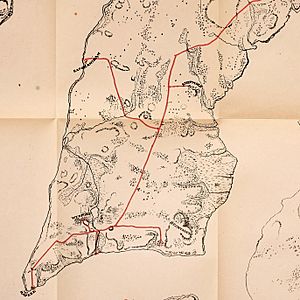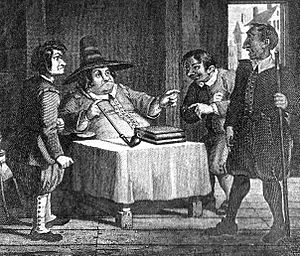Sapohanikan facts for kids

Sapohanikan was a village where the Lenape people, specifically the Canarsee tribe, once lived. This village was located near where Gansevoort Street and Washington Street meet today in Manhattan, close to the Hudson River. Sadly, the people of Sapohanikan were forced out of their home in the 1630s by the Dutch, led by Governor Wouter van Twiller. He wanted to use the land for a tobacco farm for the Dutch West India Company.
For many years, the area we now call Greenwich Village was known as Sapokanikan during the time of the New Netherland colony. This name was used until the British took control. Historical records show the name spelled in different ways, like Sapohanikan in 1639, Sappokanican in 1640, and both Sapokanikan and Saponickan in 1641.
Contents
What Does the Name Sapohanikan Mean?
The name Sapohanikan likely comes from the Lenape language. It might mean "over against the pipe-making place" or "at the tobacco-pipe land." This suggests the area was known for tobacco or for making pipes.
Interestingly, the name of Hoboken, New Jersey, which is across the Hudson River from where Sapohanikan was, also has a similar meaning. "Hopoghan Hackingh" means "land of the tobacco pipe." This is probably because people found soapstone there, which they used to carve tobacco pipes.
A Look at Sapohanikan's History
Life Before Europeans Arrived
Sapohanikan was one of at least eighty places where the Lenape people lived in what is now New York City. Archaeologists have found evidence of these villages, along with planting fields and paths connecting them. Other nearby villages included Nechtanc to the southeast and Konaande Kongh to the northwest.
Sapohanikan was a place where people fished and grew crops. It was located along paths that led west towards the Hudson River. The village's name came from the Lenape word for tobacco, which was probably grown there, as the area around the settlement was farmed. Sapohanikan might have been a seasonal village, perhaps important for harvesting oysters.
How the Village Was Lost
In the early 1630s, the Dutch settlement of Noortwyck (meaning "north village") started to expand closer to Sapohanikan.
In 1633, the land around Sapohanikan was turned into a tobacco farm by New Netherland Governor Wouter van Twiller. He called it the Bossen Bouwerie, which means "the farm in the woods." Van Twiller was known for taking land from the Native Americans. He forced the people of Sapohanikan out through "intermittent, bloody warfare."
Van Twiller's farm quickly grew to 300 acres. It stretched from Minetta Waters (now underground in Manhattan) all the way to the Hudson River. Even though the farm was supposedly for the Dutch West India Company, Van Twiller kept most of the money for himself.
The Bossen Bouwerie continued to grow in the 1640s. Records show that Dutch landowners bought and sold parts of this farm, calling it the "plantation at Sapokanikan." Other Dutch farms also started up nearby, like the Farm of Coseyn in 1647, which was located along the Sapokanikan wagon road.
In the 1670s, Noortwyck was officially renamed Greenwijk ("Pine District"). Later, in 1696, it was called Greenwich Village in Yellis Mandeville's will. As Greenwich grew under British rule, the name Sapokanikan was no longer used for the area. The rich land around what was once Sapohanikan soon became home to large estates.
Remembering Sapohanikan Today
In 2001, there was a suggestion to name a park at 14th Street the Sapohanikan Park. This idea was presented to the Hudson River Park Trust. However, the park was never officially named Sapohanikan. As of 2022, it is still called the 14th Street Park on the Hudson River Park website.
Artist Beatriz Cortez created a monument called Sapohanikan Market. You can find it at Gansevoort Market.


